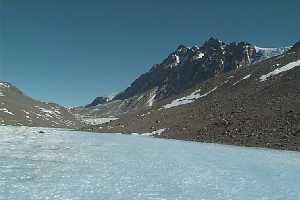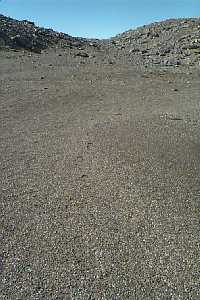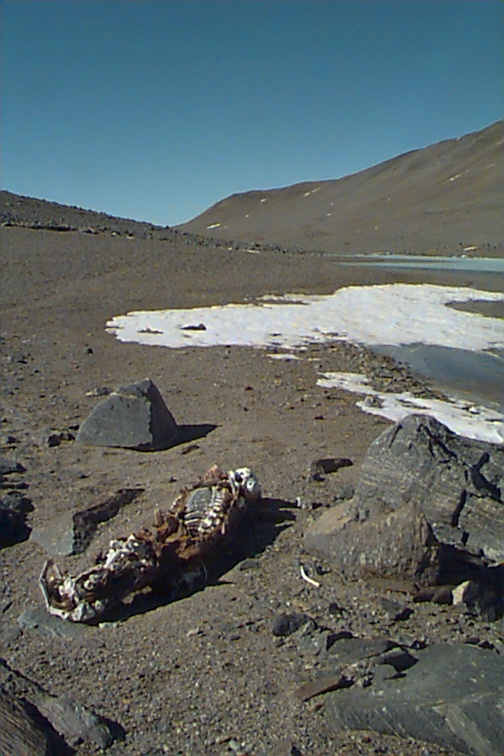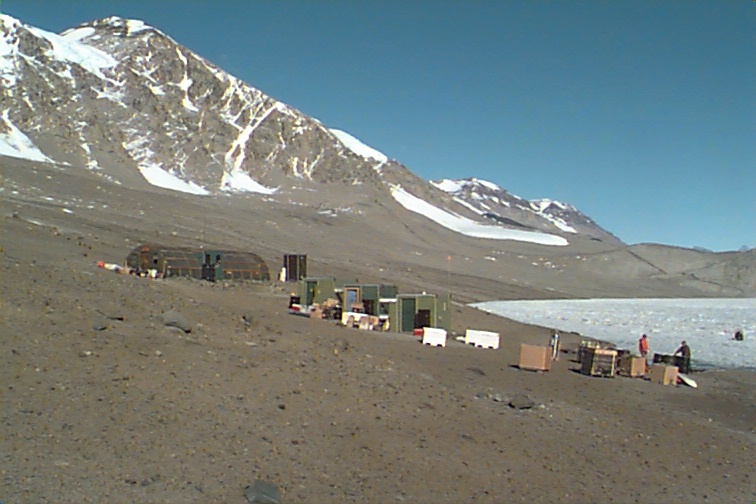
So I put stuff into a backpack, zipped up my tent, and strode off fearlessly and cluelessly.
Walking Out Of Time
A couple of years ago, helicopter transportation was provided not only by the contractor but also by the New Zealand air force. The young Kiwi pilots were a happy bunch, it was said, unencumbered by caution and eager to fly under any conditions. On two occasions they were flying when others wouldn't, and were obliged by the weather to land in a manner that you or I would best describe as a 'controlled crash'. However, the euphemism used to describe the reason why their helo's had to be towed in was that they had "over-torqued the transmission", i.e. driven it beyond its design limits in order to survive.
I was to experience this concept.
(Note: the Kiwi helo's are no longer on The Ice)
- - - -
It was a calm hot sunny day at Lake Hoare, a Wednesday.
Yes, HOT. Well, the air wasn't very hot, but the sun
sure was. The aethalometer was working great and I had some hours
before I needed to check it again. There had been periods of cold
clouds and strong winds, but with the fine weather I asked Rae if I should
go for a walk, to hike along the valley. Absolutely, she said, take
a radio and your wind gear in case, take drinking water and your urine
bottle, and here are some ice creepers (a sort of velcro sandal with metal
studs to strap onto normal hiking boots - and surprisingly effective).

So I put stuff into a backpack, zipped up my tent, and
strode off fearlessly and cluelessly.
The center ice cap of the lake was a jumbled nightmare of eroding ice pinnacles, reminding me of something in Death Valley or Mono Lake. Apparently the fresh water runs into the bottom of the lake from galcier melt, and freezes in the winter onto the underneath of the lake's ice cap. Ice is removed from the top by wind erosion, melting and sublimation, so the ice is constantly forming on the bottom and moving up towards the surface, where it is carved away into fantastic shapes. The process takes about 10 years and keeps the underlying water isolated from most effects of the atmosphere. The center of the lake was impassable, but around the edges there was smooth firm ice to walk on. I scrunched along and then saw HUGE ROCKS out on the center ice. How on earth had they got there? Why didn't they melt down into holes in the ice? Some were taller than I. (I asked this question to one of the lake scientists back in camp and it turns out that this is a hotly-debated and as-yet-unresolved topic among the cognoscenti.)

There's a mountain with 3 peaks on the north side of
the valley. I was told that the peaks are named the Matterhorn,
the Anti-Matterhorn, and the What's-the-Matterhorn. After
a while, I passed the end of Lake Hoare and reached a smaller lake up against
the next glacier.
As I walked along on the shore, I was acutely aware of
the fact that the surface of the ground was perfect : that is to
say, it was a marquetry of small flat stones, each perhaps an inch or so,
all laid side to side with hardly any gaps. The spaces were filled
with progressively smaller gravel and sand until the surface was smooth
and looked as if it had been rolled flat. (I later found out that
this is due to the unbelievable winter winds).

I looked behind me: there were footsteps!
- but there was not another living soul for miles! ..... It turned
out that they were my footsteps: how long would they last?
What had I done?
..
..
Over a slight rise, down a little slope, I came across
a corpse. And then another corpse.
..
..


Each made out of windblasted bone and leather as hard as stone. These guys had taken a wrong turn down at the coast, a fatal mistake at the time. But when was that time? Which Roman emperor was ruling, which Pharaoh sat on his gilded throne, when these seals hauled themselves out of the icy water of McMurdo Sound and went the wrong way?
They wouldn't answer. Radiocarbon data puts some
of them before the dawn of recorded civilization. But time isn't
the same in the Dry Valleys. A geologist told me that some of the
scree slopes have been there for three million years. It certainly
hasn't rained for at least two million years.
 I hiked up the "Defile", a narrow crack between the hillside on my left
and the very front edge of the Suess Glacier on my right. Melting
water dripped on me and ran along the ground in rivulets to the lakes of
no outlet. I felt as if I was being extruded by the press of implacable
forces.
I hiked up the "Defile", a narrow crack between the hillside on my left
and the very front edge of the Suess Glacier on my right. Melting
water dripped on me and ran along the ground in rivulets to the lakes of
no outlet. I felt as if I was being extruded by the press of implacable
forces.
I reached 'Mummy Pond', named for the mummified seals
.. but I didn't really see any, maybe they were on the other side.


The landscape, the view were incredibly sublime. I couldn't believe I was really there. I couldn't believe I was in Antarctica. Maybe this is what it's like in the highest of the High Sierras, or the Rockies .. but here there were no insects, no birds, no moss, no airplane trails, no chipmunks. There was just me and a thousand-year-old seal carcass.
After more of what is probably Tibet, there is Lake Bonney
with its (smaller) research camp.


But despite the setting, it wasn't the Potala. Not at all. And the handful of people inside were nursing astounding hangovers, a combination of a sophomoric going-away party and the zero humidity. Somehow, the absence of a permanent camp manager eliminated the civilizing influence of personal continuity. These people had been camping for weeks: the domestic disorder, the empties were the proof. 101 proof.
It was a long way back.
The sun went behind the mountains and the air suddenly got as cold as it really was. The wind had been resting all afternoon, so it was ready for my face. All the way back.
Squishing past the glacier defile wasn't fun.
Splashing through the melt pools on the lake ice wasn't fun.
I (obviously) did make it. I even made it in time for dinner.
But I had over-torqued my feet.